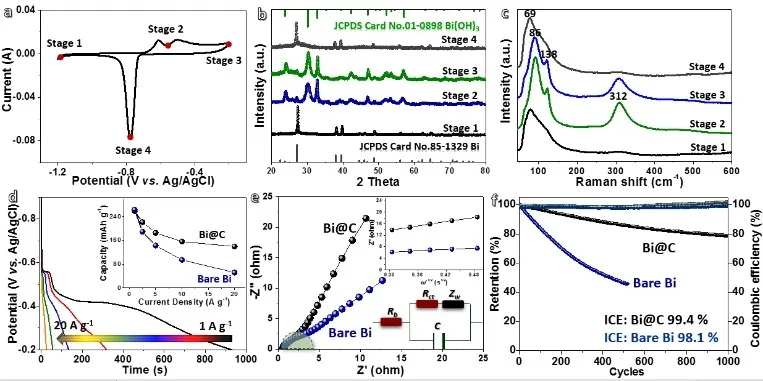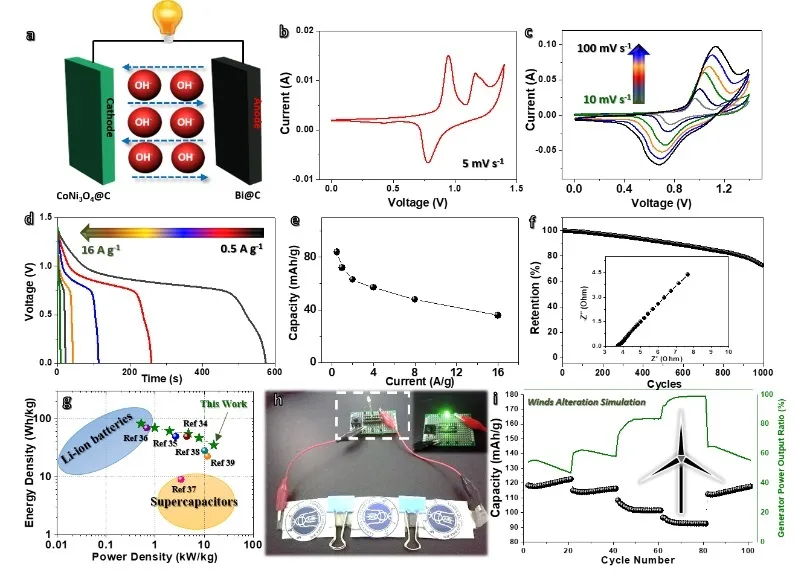
hotline:
17715390137
Tel/Wechat:
18101240246 (Technology)
0512-68565571
Email:mxenes@163.com (Sales Engineer)bkxc.bonnie@gmail.com
Scan the code to follow or search the official account on WeChat:
2D Materials Fronrier After paying attention,
click on the lower right corner to contact us,
Enter enterprise WeChat.
Professional Services Online

Porous bismuth-carbon composite nanoparticles help achieve fast response and stable nickel-bismuth batteries
In practical applications, the use of renewable natural energy such as solar energy, wind energy, and tidal energy will be limited and affected by factors such as time, place, and climate. The best way to use it is to efficiently convert it into electrical energy and immediately store it in a dedicated battery device. Water-based secondary batteries have significant advantages in terms of power performance, operation and maintenance costs, and safety assurance, so they have broad application prospects in the field of large-scale power grid energy storage. Metal bismuth (Bi) is considered as one of the negative electrode materials for rechargeable aqueous batteries due to its large volume capacity (~ 3765 mAh cm-3), suitable working potential window, and highly reversible redox reaction. However, the electrochemical stability of Bi-based electrode materials is poor, which makes the design and development of full-cells very slow. To make matters worse, Bi-based materials (such as bismuth oxide, etc.) are easy to decompose into elemental materials after heating, and the melting point of elementary Bi is relatively low (only about 271 ° C), and the resulting products are prone to "melt aggregation". Therefore, it is difficult to achieve a structure-controllable Bi-based composite material (especially a nanomaterial) through traditional inexpensive electrode interface optimization techniques (such as carbon modification) to alleviate the problems of battery specific capacity attenuation and poor stability.
Recently, Jiang Jian‘s group from the School of Materials and Energy of Southwest University proposed a more unique electrode material processing scheme, that is, using NH₄Bi₃F ₀ nanospheres as precursors, and successfully obtained hollow Bi simple nanoparticle @ carbon composite material after high temperature treatment. It is worth emphasizing that after heating at high temperature, its nano-scale structure remains almost unchanged and no fusion occurs. We believe that the high heat resistance (annealing temperature increased to 400oC) exhibited during the processing of this material is closely related to the high binding energy of the Bi-F chemical bond. This Bi @ carbon composite has a unique hollow nanostructure, has a high specific surface area, unobstructed ion transmission channels, and strong mechanical stability. When used as a negative electrode material, it can exhibit high specific capacity and rate characteristics. (53.9% capacity retention rate at high current density of 20 A g-1), and long cycle life (capacity retention rate exceeds 80% after 1000 cycles). More importantly, through the in-situ characterization (such as XRD, Raman) analysis of the electrode at different cycle stages, we further confirmed the unique reversible phase transition process of the anode, namely "Bi ↔ Bi (OH) 3", the assembled Ni- Bi full battery has excellent energy / power density, fast response capability and sufficiently stable electrochemical performance, which is suitable for fast collection and storage of electricity generated by new energy.


Figure 2 Electrochemical performance test results of Bi @ carbon composite nanoparticles.

http://dx.doi.org/10.1039/D0QM00017E
Frontiers Journals

| Reminder: Beijing Beike New Material Technology Co., Ltd. supplies products only for scientific research, not for humans |
| All rights reserved © 2019 beijing beike new material Technology Co., Ltd 京ICP备16054715-2号 |